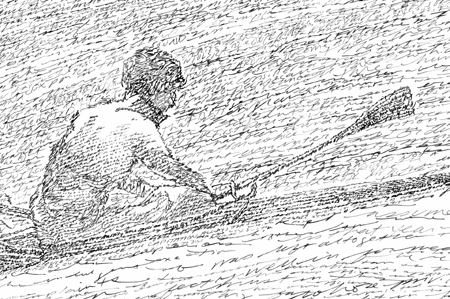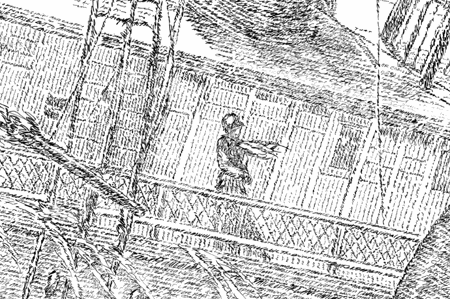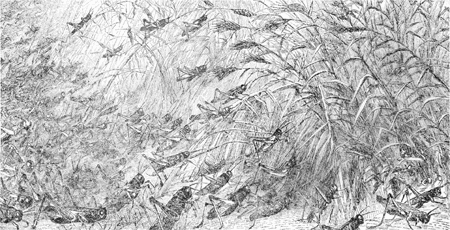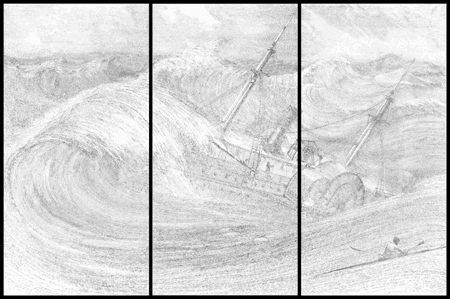Meet a NYFA Artist: Michael Waugh
Political Economy (The Wealth of Nations, parts 19, 20, & 21). 2012, ink on Mylar, three panels at 84"x42" each
Photo Credit: D. James Dee
NYFA talks to Michael Waugh (2009 Printmaking/Drawing/Artists Books Fellow) about his current exhibition, incorporating multidisciplinary elements into his work, relating text to images, and rowing a boat across Buzzards Bay.
NYFA: Tell us about your process. How would you describe what you do?
MW: The drawings that I make use a technique called micrography, in which tiny hand-written words form a visual image. The technique has been around since at least the 12th century. I don’t think that my drawings would be all that remarkable if they were only concerned with this traditional form. The creative site of my work is the relationship between text and image. I work with that relationship in the drawings as well as in performance, video, and sculpture.
NYFA: How did you arrive at your medium?
MW: I earned a BA in history and an MFA in poetry before studying visual art, so I came at art-making with all those disciplines in tow. Before I started making the micrographic drawings, my drawings used text in several ways, handwritten as well as font-based, alongside drawn and painted elements. As with my current drawings, those older drawings and the texts that I used were made in conjunction with multi-media work and sculpture. The first time I used micrography, I thought it would just be a one-off. But I got caught up in the possibilities – and found that the micrography solved a lot of the formal issues that I’d been having in my drawings.

detail from Political Economy (The Wealth of Nations, parts 19, 20, & 21). 2012, ink on Mylar
Photo Credit: D. James Dee
NYFA: How do you choose a text to work with and how do you relate the text to the images you depict?
MW: To a certain degree, I choose texts because I want to know more about them. I have been using important texts dealing with economics and the federal budget recently because, after the crash, I wanted to know more about those topics. But within that field, there are thousands of choices of important texts. The next step involves a lot of back and forth – looking at images – reading articles – looking at how money affects my life on a daily basis – repeating this process over several months. The titles of my work always make clear the text that I use. From my perspective, the relationship between the text and the context that I create is the most important thing

detail from Political Economy (The Wealth of Nations, parts 19, 20, & 21). 2012, ink on Mylar
Photo Credit: D. James Dee
NYFA: You have an exhibition that opened on Jan. 12 at Winkleman Gallery, in conjunction with your long term gallery Schroeder Romero. Tell us about the work in this exhibition and about your ongoing rowing project.
MW: To a certain degree, the show that just opened is a prequel to a larger project. Almost every piece in the show has rowing imagery in it – portraits of university crew, images of boat-houses, hand-made oars covered in hand-written text, etc. And the most prominent text that I’m engaging with is Adam Smith’s The Wealth of Nations, which is a foundational text for capitalism. My next project will not just have oars covered with text but a whole boat, and I’m going to row that boat across Buzzards Bay in Massachusetts, retracing the final, fatal voyage of my great-great-great-great grandfather.
NYFA: What has been the most gratifying part of this project?
MW: The most gratifying part of this project has been working outside of my studio. I’ve had to learn woodworking skills, how to row, and I’m learning about the processes of the ocean. My work has always been engaged with ideas. But ideas don’t mean much without people. I’m figuring out how to engage with people as part of my process instead of just as an audience. It’s nice to move beyond the producer/consumer dichotomy.

detail from Political Economy (The Wealth of Nations, parts 19, 20, & 21). 2012, ink on Mylar
Photo Credit: D. James Dee
NYFA: You incorporate elements of performance, such as video and live readings, into your work. What has led you to develop this multidisciplinary approach and what direction do you see your work moving toward from here?
MW: I earned my degree in poetry before I started making visual art, so I was giving readings and performing first. When I went back to school at NYU for visual art, I adopted a multi-disciplinary approach by incorporating what used to be called the plastic arts into my writerly practice. One of the best classes I took was with Marina Abramovic, who helped me see some new possibilities. My graduate thesis consisted of video and installation, and I’ve continued to work in various disciplines since then. However, the market has given more exposure to my drawings than to my other work. My hope is that as my career progresses, I’ll have more chances to show the full context of my practice. One way that I’m working towards that is through things like the rowing project that engage directly with a community instead of relying on salability to find an audience.

The American Jobs Act, part 2. 2012, ink on Mylar, 42"x82"
Photo Credit: D. James Dee
NYFA: On the business side of things, what do you consider to be the most challenging aspect of managing your career as an artist?
MW: I think that, like most artists, I am a horrible networker. Unless someone asks, I just don’t talk about my work (so thanks for this opportunity!). Part of managing one’s career is getting the word out to writers, curators, other artists. But I think that it’s important to try to make those connections in a genuine way and not out of self-interest. I think that most artists live their careers in the same way as I do. Nonetheless, it presents a challenge that I feel acutely.
NYFA: What advice do you have for up-and-coming artists, especially in terms of managing a career?
MW: The best thing emerging artists can do is be generous. Be generous with your time. Visit friends’ studios. Volunteer at non-profits. Ask dealers questions about their businesses. And do all of these things out of genuine curiosity. Presumably, we are all in the art world because we love art. But it’s easy to fall into the false political consciousness of believing that artists are in competition with each other. We aren’t.

detail from The American Jobs Act, part 2. 2012, ink on Mylar, 42"x82"
Photo Credit: D. James Dee
NYFA: Who/what influences your work?
MW: The great thing about living in New York is that I am surrounded by creative people and have the opportunity to see hundreds of shows, good and bad. I see a lot of work that I find deeply problematic (usually for political reasons. The visual form of a work is rarely what I respond to first). But then I walk into a show like Janet Biggs’ video installation at Smack Mellon, and I realize why I do what I do and why I live here. I am equally motivated to respond to her work as to the artists whose work I find problematic. I guess what I’m saying is that what influences me is being part of a dialogue. Though, to be honest, listening to Democracy Now and NPR, or reading John Kenneth Galbraith (my current reading), influence me as much as any art or artist.
NYFA: In 2009, you won a NYFA Fellowship in Printmaking/Drawing/Book Arts. How has this award affected your work and your career?
MW: The NYFA award had a huge impact on my career. I am convinced that the NYFA Fellowship gave me the visibility to go on and get two more awards in rapid succession, and I know that people who saw my work because of NYFA have then gone on to visit my shows. So the award has really helped to build an audience for my work. As I said earlier, I’m not a world-class networker. So NYFA’s stamp of approval has done a lot to help promote me in ways that would be difficult for me. On a practical level, I used the grant to buy a new computer, which I desperately needed. I plan my drawings in Photoshop and my old computer took several minutes to render any changes. Between making 45-layered Photoshop files and processing video, my old computer would get burning hot and whine miserably. I would have worked that little laptop into the ground, and probably I would have lost work. So the grant and the new computer were of huge assistance. The timing of the award was incredibly fortuitous, and for that I am deeply grateful.
—Interview by Michon Ashmore
For more information on Michael, please visit his website.




